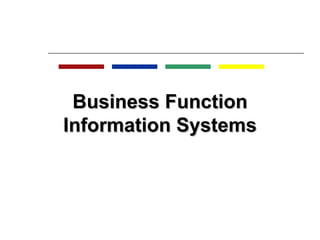Types of business function information systems
- 1. Business Function Information Systems
- 2. Systems from a functional perspective Order Processing systems Manufacturing and production systems Finance and accounting systems Payroll systems Inventory system
- 3. Order Processing systems Functional concerns include: Sales management, customer identification market research, advertising and promotion, pricing, new products Examples of systems: Order processing (operational level) Pricing analysis (middle mgmt) Sales trend forecasting (senior mgmt)
- 4. Ěý
- 5. Example of a Sales Information System Figure 2-2 This system captures sales data at the moment the sale takes place to help the business monitor sales transactions and to provide information to help management analyze sales trends and the effectiveness of marketing campaigns.
- 6. Manufacturing and production systems Functional concerns include: Managing production facilities, production goals, production materials, and scheduling Examples of systems: Machine control (operational mgmt) Production planning (middle mgmt) Facilities location (senior mgmt)
- 7. Ěý
- 8. Overview of an Inventory System This system provides information about the number of items available in inventory to support manufacturing and production activities.
- 9. Why was it so difficult for Kia to identify sources of defects in the cars it produced? What was the business impact of Kia not having an information system to track defects? What other business processes besides manufacturing and production were affected? How did Kia’s new defect-reporting system improve the way it ran its business? What management, organization, and technology issues did Kia have to address when it adopted its new quality control system? What new business processes were enabled by Kia’s new quality control system? Information Systems Help Kia Solve Its Quality Problems
- 10. Finance and accounting systems Functional concerns include: Managing financial assets (cash, stocks, etc.) and capitalization of firm, and managing firm’s financial records Examples of systems: Accounts receivable (operational mgmt) Budgeting (middle mgmt) Profit planning (senior mgmt)
- 11. An Accounts Receivable System An accounts receivable system tracks and stores important customer data, such as payment history, credit rating, and billing history.
- 12. Human resource systems Functional concerns include: Identifying potential employees, maintaining employee records, creating programs to develop employee talent and skills Examples of systems: Training and development (operational mgmt) Compensation analysis (middle mgmt) Human resources planning (senior mgmt)
- 13. An Employee Record Keeping System This system maintains data on the firm’s employees to support the human resources function.












